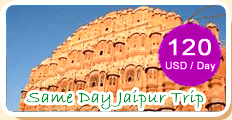
Ajmer Tour

South west of Jaipur, Ajmer is an oasis wrapped in the green hills. The city was founded by Raja Ajay Pal Chauhan in the 7th Century A.D. and continued to be a major centre of the Chauhan power till 1193 A.D. When Prithviraj Chauhan lost it to Mohammed Gaure. Since then, Ajmer became home to many dynasties. Today, Ajmer is a popular pilgrimage centre for the Hindus as well as Muslims. Especially famous is the Dargah Sharif-tomb of the Sufi saint Khwaja Moinuddin Chisti, which is equally revered by the Hindus and Muslims. It is a centre of culture and education, the British chose Ajmer for its prestigious Mayo College a school exclusively for Indian nobility. Ajmer is also the base for visiting Pushkar (14 km.), the abode of Lord Brahma, lying to its west with a temple and a picturesque lake. The Pushkar Lake is a sacred spot for Hindus. During the month of Kartik (Oct./Nov.), devotees throng in large numbers here to take a dip in the sacred lake.
Ajaipal Chauhan founded Ajmer in the seventh century. He constructed a hill fort "Ajaimeur" or the invincible hill. The Chauhans ruled Ajmer till the 12th century when Prithviraj Chauhan lost Mohammed Ghauri. Thereafter it became a part of the sultanate of Delhi. Ajmer was also favourite residence for the great Mughals. One of the first contacts between the Mughal King Jahangir and Sir Thomas Roe took place here in 1616. The Scindias took over the city in 1818 and then handed it over to the British and it became one of the only part of Rajasthan controlled directly by the East Indian Co.
The bus stand in Ajmer is located near the RTDC hotel Khadim. And the railway is further north and most of the hotels are west of the stations. Northeast is the main post office and most of the cities market is located behind and up to Agra Gate. Further north is a large artificial lake called the Anna Sagar.
Places of Interest
Dargah Khwaja Sahib
It is the landmark of Ajmer and one of the holiest of Muslim shrines in the country. It has a secular appeal and revered by people of all sect. Khwaja Moin-ud-din Chisti, a Sufi saint from Persia made this place his abode from 1192 till he died in 1236 AD. Mughal King Humayun completed the construction of the shrine. The Dargah is approached through a massive gate with silver doors built in several stages. Emperor Akbar made an annual pilgrimage to Ajmer. Mughal Emperors Akbar and Shah Zahan have built mosques in the complex. The saint's tomb is in the centre of the second courtyard and the actual tomb inside is surrounded by a silver railing and partly by a marble screen. The tomb is of marble and dome is gold plated. The atmosphere inside the shrine is charged and supernatural with burning of incense and offerings of flowers mainly rose and sweets.
As you enter the Dargah courtyard, you see two massive 'degs' meaning cauldrons. Mughal Emperors Akbar and Jahangir donated these cauldrons originally but they have been replaced in the nineteenth century. The larger cauldron can contain as much as 4480 kgs of rice while the smaller one contains 2240 kgs of rice.
The shrine comes alive with activity when millions of devotees throng the shrine during Urs fair. Urs is held on the seventh lunar month according to Islamic calendar and is variable according to the solar calendar. Sufis and believer converge from all over India and abroad, as it is believed that those visiting during Urs receives special blessings of the saint. It is compulsory that you cover your head while inside the complex so remember to carry a skullcap or a scarf. The skull-cap is on sale in the colourful market just outside the Dargah. It is also customary to make floral offerings mainly of roses, incense sticks and sweets that are locally available.
Nasiyan Red Temple
The red temple is a Digambar Jain temple which has a double- storey hall adjacent to the main temple. The hall displays a series of large gold plated wooden figures depicting legends from Jain mythology. The entire hall is richly adorned by glass mosaic, precious stones, gold and silver work. The place is also popularly called Soni Ji Ki Nasiyan.
Taragarh Fort
The giant fort stands guarding the city. It has six gates. The fort also has Miran Saheb ki Dargah who was the governor of the fort and laid down his life in an encounter. It gives a panoramic view of the city situated in Nagpahari of Aravalli ranges, this fort has immense archaeological and historical importance.
Ajaipal Chauhan founded Ajmer in the seventh century. He constructed a hill fort "Ajaimeur" or the invincible hill. The Chauhans ruled Ajmer till the 12th century when Prithviraj Chauhan lost Mohammed Ghauri. Thereafter it became a part of the sultanate of Delhi. Ajmer was also favourite residence for the great Mughals. One of the first contacts between the Mughal King Jahangir and Sir Thomas Roe took place here in 1616. The Scindias took over the city in 1818 and then handed it over to the British and it became one of the only part of Rajasthan controlled directly by the East Indian Co.
The bus stand in Ajmer is located near the RTDC hotel Khadim. And the railway is further north and most of the hotels are west of the stations. Northeast is the main post office and most of the cities market is located behind and up to Agra Gate. Further north is a large artificial lake called the Anna Sagar.
Places of Interest
Dargah Khwaja Sahib
It is the landmark of Ajmer and one of the holiest of Muslim shrines in the country. It has a secular appeal and revered by people of all sect. Khwaja Moin-ud-din Chisti, a Sufi saint from Persia made this place his abode from 1192 till he died in 1236 AD. Mughal King Humayun completed the construction of the shrine. The Dargah is approached through a massive gate with silver doors built in several stages. Emperor Akbar made an annual pilgrimage to Ajmer. Mughal Emperors Akbar and Shah Zahan have built mosques in the complex. The saint's tomb is in the centre of the second courtyard and the actual tomb inside is surrounded by a silver railing and partly by a marble screen. The tomb is of marble and dome is gold plated. The atmosphere inside the shrine is charged and supernatural with burning of incense and offerings of flowers mainly rose and sweets.
As you enter the Dargah courtyard, you see two massive 'degs' meaning cauldrons. Mughal Emperors Akbar and Jahangir donated these cauldrons originally but they have been replaced in the nineteenth century. The larger cauldron can contain as much as 4480 kgs of rice while the smaller one contains 2240 kgs of rice.
The shrine comes alive with activity when millions of devotees throng the shrine during Urs fair. Urs is held on the seventh lunar month according to Islamic calendar and is variable according to the solar calendar. Sufis and believer converge from all over India and abroad, as it is believed that those visiting during Urs receives special blessings of the saint. It is compulsory that you cover your head while inside the complex so remember to carry a skullcap or a scarf. The skull-cap is on sale in the colourful market just outside the Dargah. It is also customary to make floral offerings mainly of roses, incense sticks and sweets that are locally available.
Nasiyan Red Temple
The red temple is a Digambar Jain temple which has a double- storey hall adjacent to the main temple. The hall displays a series of large gold plated wooden figures depicting legends from Jain mythology. The entire hall is richly adorned by glass mosaic, precious stones, gold and silver work. The place is also popularly called Soni Ji Ki Nasiyan.
Taragarh Fort
The giant fort stands guarding the city. It has six gates. The fort also has Miran Saheb ki Dargah who was the governor of the fort and laid down his life in an encounter. It gives a panoramic view of the city situated in Nagpahari of Aravalli ranges, this fort has immense archaeological and historical importance.
























